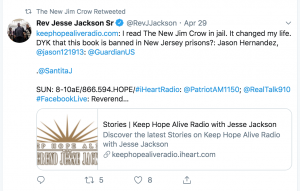Recently, dialogue concerning the prospect of prison reform has reached mainstream conciousness because of celebrities such as Kim Kardashian, Meek Mill, and Jay-Z who have used their hyper-visible platforms to bring attention to the problems of the U.S.’s criminal justice system. Yet, even before the idea of prison reform was made ‘sexy’ by the involvement of high-profile celebrities today, this issue has been the basis of many black activists’ platforms for decades, one of those activists being Michelle Alexander. Alexander formerly served as the director of the Racial Justice Project at the American Civil Liberties Union of Northern California. The ACLU is a non-profit organization whose objective is to maintain the civil rights of Americans, specifically those rights that pertain to what is outlined by the Constitution and the United States law. The group is multi-functioning as it operates not only as an advocacy group, but also as a law firm and as a charity. Alexander’s focus within the ACLU was primarily on exposing and dealing with the biases of the criminal justice system and how those biases disproportionally and devastatingly affect black communities. During her time at the ACLU, she initiated and managed the ‘Driving While Black or Brown’ advertising campaign which sought to challenge patterns of racial profiling by police that specifically targets Black and Brown people. In a statement for the ACLU with regards to the DWBB campaign, Alexander said: “The ACLU is determined to put a stop to racist police practices in our neighborhoods and on our freeways.”
I would refer to Alexander as being a radical activist not only because of her work with criminal justice reform, but, too, because her platform is rooted in the idea that in order to bring about substantial change for the criminal justice system, we must uproot the racial caste system that still plagues America’s institutions and ideologies. She recognizes that injustice against Black and Brown peoples does not begin with the criminal justice system, nor does it end there. There are foundational racist ideologies that have permeated the criminal justice system and perpetuated the maltreatment of Black and Brown people. In her 2010 groundbreaking novel The New Jim Crow: Mass Incarceration in the Age of Colorblindness, Alexander demonstrates how Jim Crow laws of the late 1800s to the mid-1950s have simply been repackaged and redesigned in our 21st century reality so to maintain the subjugation of Black and Brown people. The ideas that the novel presents have been perceived as being so radical that several prisons across the country banned the book from their institutions including the prisons of New Jersey and North Carolina. Those bans did not stop the momentum or impact of Alexander’s novel as he novel has since been cited in judicial decision has been included in campus-wide curriculums. Alexander has shifted her approach to tackling the injustices of the criminal justice system as she now works as a visiting professor at the Union Theological Seminary where she, with her students, explores the morality and spirituality that underlies mass incarceration.

This tweet that civil rights activist Reverend Jesse Jackson Sr. tweeted demonstrates just how powerful Alexander’s novel can be. Her novel has the power to change lives on both the macro and micro levels.

In this short excerpt from Michelle Alexander’s novel ‘The New Jim Crow: Mass Incarceration in the Age of Colorblindness’ Alexander demonstrates how the incarceration of African Americans reinforces their subjugation and inferiority in the eyes of the racist mainstream of society.
Michelle Alexander and civil rights activist Angela Davis have a discussion about the state of civil rights today with both agreeing that there’s been a sort of stagnation in progress towards equality and equity for Black people in the United States. The cycle of oppression has proven to be no less destructive than it has been since the fight against it began, it’s only been repackaged to affect people differently. But they assure that there is still hope for a better future, one where Black and Brown people are not persecuted for the color of their skin.

